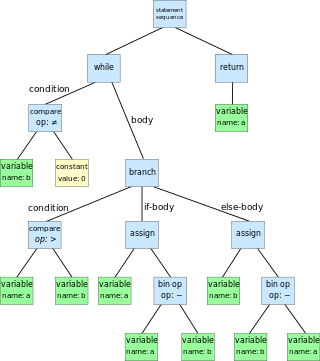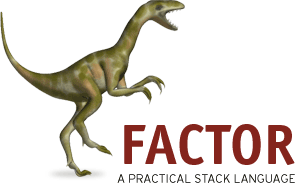
The Document Object Model (DOM) is a cross-platform and language-independent interface that treats an HTML or XML document as a tree structure wherein each node is an object representing a part of the document. The DOM represents a document with a logical tree. Each branch of the tree ends in a node, and each node contains objects. DOM methods allow programmatic access to the tree; with them one can change the structure, style or content of a document. Nodes can have event handlers attached to them. Once an event is triggered, the event handlers get executed.
In computing, a namespace is a set of signs (names) that are used to identify and refer to objects of various kinds. A namespace ensures that all of a given set of objects have unique names so that they can be easily identified.

The Standard Generalized Markup Language is a standard for defining generalized markup languages for documents. ISO 8879 Annex A.1 states that generalized markup is "based on two postulates":

Extensible Markup Language (XML) is a markup language and file format for storing, transmitting, and reconstructing arbitrary data. It defines a set of rules for encoding documents in a format that is both human-readable and machine-readable. The World Wide Web Consortium's XML 1.0 Specification of 1998 and several other related specifications—all of them free open standards—define XML.
XSLT is a language originally designed for transforming XML documents into other XML documents, or other formats such as HTML for web pages, plain text or XSL Formatting Objects, which may subsequently be converted to other formats, such as PDF, PostScript and PNG. Support for JSON and plain-text transformation was added in later updates to the XSLT 1.0 specification.
In computer science, Backus–Naur form is a notation used to describe the syntax of programming languages or other formal languages. It was developed by John Backus and Peter Naur. BNF can be described as a metasyntax notation for context-free grammars. Backus–Naur form is applied wherever exact descriptions of languages are needed, such as in official language specifications, in manuals, and in textbooks on programming language theory. BNF can be used to describe document formats, instruction sets, and communication protocols.

An abstract syntax tree (AST) is a data structure used in computer science to represent the structure of a program or code snippet. It is a tree representation of the abstract syntactic structure of text written in a formal language. Each node of the tree denotes a construct occurring in the text. It is sometimes called just a syntax tree.
A web service (WS) is either:
In computing, RELAX NG is a schema language for XML—a RELAX NG schema specifies a pattern for the structure and content of an XML document. A RELAX NG schema is itself an XML document but RELAX NG also offers a popular compact, non-XML syntax. Compared to other XML schema languages RELAX NG is considered relatively simple.
Apache Cocoon, usually abbreviated as Cocoon, is a web application framework built around the concepts of Pipeline, separation of concerns, and component-based web development. The framework focuses on XML and XSLT publishing and is built using the Java programming language. Cocoon's use of XML is intended to improve compatibility of publishing formats, such as HTML and PDF. The content management systems Apache Lenya and Daisy have been created on top of the framework. Cocoon is also commonly used as a data warehousing ETL tool or as middleware for transporting data between systems.
An XML schema is a description of a type of XML document, typically expressed in terms of constraints on the structure and content of documents of that type, above and beyond the basic syntactical constraints imposed by XML itself. These constraints are generally expressed using some combination of grammatical rules governing the order of elements, Boolean predicates that the content must satisfy, data types governing the content of elements and attributes, and more specialized rules such as uniqueness and referential integrity constraints.

Factor is a stack-oriented programming language created by Slava Pestov. Factor is dynamically typed and has automatic memory management, as well as powerful metaprogramming features. The language has a single implementation featuring a self-hosted optimizing compiler and an interactive development environment. The Factor distribution includes a large standard library.
In computer science, graph transformation, or graph rewriting, concerns the technique of creating a new graph out of an original graph algorithmically. It has numerous applications, ranging from software engineering to layout algorithms and picture generation.
A user interface markup language is a markup language that renders and describes graphical user interfaces and controls. Many of these markup languages are dialects of XML and are dependent upon a pre-existing scripting language engine, usually a JavaScript engine, for rendering of controls and extra scriptability.
A program transformation is any operation that takes a computer program and generates another program. In many cases the transformed program is required to be semantically equivalent to the original, relative to a particular formal semantics and in fewer cases the transformations result in programs that semantically differ from the original in predictable ways.
The Prototype JavaScript Framework is a JavaScript framework created by Sam Stephenson in February 2005 as part of Ajax support in Ruby on Rails. It is implemented as a single file of JavaScript code, usually named prototype.js. Prototype is distributed standalone, but also as part of larger projects, such as Ruby on Rails, script.aculo.us and Rico. As of March 2021, according to w3techs, Prototype is used by 0.6% of all websites.
Scribe is a markup language and word processing system that pioneered the use of descriptive markup. Scribe was revolutionary when it was proposed, because it involved for the first time a clean separation of presentation and content.
XQuery is a query and functional programming language that queries and transforms collections of structured and unstructured data, usually in the form of XML, text and with vendor-specific extensions for other data formats. The language is developed by the XML Query working group of the W3C. The work is closely coordinated with the development of XSLT by the XSL Working Group; the two groups share responsibility for XPath, which is a subset of XQuery.

An XML transformation language is a programming language designed specifically to transform an input XML document into an output document which satisfies some specific goal.





